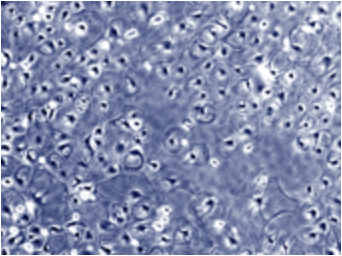Genetically modified cell lines
본문
|
Genetically modified cell lines
Celther offers genetically modified lines for use in areas such as basic research, target validation, drug discovery and drug development. Celther modified cell lines give you the tools to take your research to new heights.
Mouse immortalized peritoneal mesothelium (MDM)
The MDM cell line is established from mouse peritoneal mesothelium immortalized with large antigen SV40. The MDM cell line is characterized by a high proliferation rate. The MDM cells are large and planar rapidly covering the plate surface. At higher confluence, the MDM cells may be efficiently used as a feeder layer.
CLTH/EGFRvIII CLTH/EGFRvIII cell line stably expresses EGFRvIII and neomicin-resistant genes. Both EGFRvIII and neomicin-resistant genes are under CMV promoter control, allowing high levels of protein expression.
U87MG vIII 4.12 The U87MG vIII 4.12 clone cell line is a permanent line established from cell line derived from malignant glioma, classified as glioblastoma. U87MG vIII (4.12) cell line stably expresses high level of EGF mutant receptor vIII and G418-resistant genes introduced by plasmid stable transfection.
T96/EGFRvIII The T96 cell line is established from glioblastoma multiforme. The T96/EGFRvIII with additional point mutation C311Y cell line stably expresses mutated EGFRvIII and neomicin-resistant genes. Both mutated EGFRvIII and neomicin-resistant genes are under CMV promoter control, allowing high levels of protein expression.
DKMG/EGFR vIII Application of the DKMG/EGFRvIII cell line opens new perspectives in EGFRvIII research. EGFRvIII expression was reinduced in cells, which expressed EGFRvIII in vivo, but due to unknown reasons did not in vitro. DKMG cells show mutation at DNA level, which is responsible for the expression of EGFRvIII mRNA and protein, however, in most of these cells the expression of mutatant EGFR gene copies is silenced (these cells show the amplification of this gene). The performed biotechnological modification results in the EGFRvIII expression in all cells of the DKMG cell line.
CLTH/EFGR The CLTH/EGFR WT were stably transfected with genomic integration of a plasmid coding for EGFR receptor protein and are expressing Wild Type (WT). The expression of EGFR was confirmed by Western Blotting. The EGFR WT cells are resistant to antibiotics Puromycin used as a selection marker.
CLTH EGFR / EGFRvIII The CLTH EGFR WT/ EGFRvIII were stably transfected with genomic integration of a plasmid coding for EGFRvIII receptor protein and are expressing both Wild Type (WT) and mutated (vIII) form of Epidermal Growth Factor Receptor (EGFR). The expression of EGFR was confirmed by Western Blotting. The EGFR WT EGFRvIII cells are resistant to antibiotics Puromycin and G418 used as selection markers.
Pericytes Pericytes are mesenchymal-like cells that are associated with a network of small blood vessels. Embedded within the vascular basement membrane and adjacent to endothelial cells, pericytes are involved in stabilization of the walls of blood vessels, regulation of blood flow and angiogenesis. These cells not only participate in maturation of endothelial cells, development of new blood vessels but also help sustain the blood–brain barrier. Due to their multipotency, pericytes have the ability to differentiate into fibroblasts, smooth muscle cells adipocytes, osteoblasts, and phagocytes (macrophages)Pericyte markers: CD146, NG2, PECAM, Alpha- smooth muscle actin (ASMA), Desmin. Celther Pericytes are isolated form brain.
Ordering informations
|
▣ 관련 페이지 ; Celther Polska
댓글목록
등록된 댓글이 없습니다.
